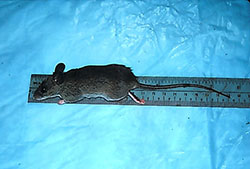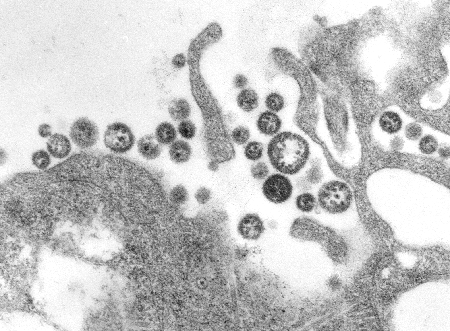Aetiology
Lassa fever has been known since the 1950s; however, the Lassa virus was not identified until 1969 when two missionary nurses died from it in Lassa, Nigeria. The virus is a member of the Arenaviridae family (genus: Mammarenavirus). The Arenaviridae are a family of viruses generally associated with rodent-transmitted diseases in humans.[16] The virus contains two single-stranded RNA molecules encapsulated by a spherical lipid membrane with a diameter of 110 to 130 nanometres. Replication of the Lassa virus is not completely understood, but it is known that new viral particles are created by budding from the surface of host cells.
The natural reservoir of the virus is the multimammate rat (Mastomys natalensis), a rodent found commonly in rural areas of tropical Africa that often colonises in or around human homes where food is stored. The Mastomys rat breeds frequently and produces large numbers of offspring.
Transmission of the virus from rodent to human occurs via human ingestion of excreta from an infected rodent, butchering and/or eating infected rodents (e.g., by subsistence farmers who routinely encounter the rodent when burning their fields ahead of the planting season, and who consider it a cheap source of protein), viral exposure to open cuts or sores, or inhaling air contaminated with infected rodent excretions (e.g., aerosol or airborne transmission may occur during cleaning activities, such as sweeping).[2][9] Infected rodents will shed the virus in excreta throughout their life.
Human-to-human transmission occurs via direct contact with body fluids (e.g., sweat, blood, urine, faeces, vomit, saliva, genital secretions [including semen], and breast milk) from infected patients, mainly in the hospital setting where protective equipment is not available or not used by healthcare personnel, or where medical equipment (e.g., needles) has not been sterilised.[9] A patient can excrete the virus in urine for between 3 and 9 weeks after the onset of illness. Sexual transmission has been reported. Patients may be able to transmit the virus via semen for up to 3 months after the onset of illness; therefore, sexual transmission may be possible after the infection has resolved.[8] Transmission to close contacts usually only occurs from symptomatic patients. It is not spread through casual contact, such as hugging, shaking hands, or sitting near someone. Human-to-human transmission is less common than rodent-to-human transmission.[9]
[Figure caption and citation for the preceding image starts]: Multimammate rat (Mastomys natalensis)CDC [Citation ends].
Pathophysiology
The typical incubation period ranges from 3 to 21 days with a median of approximately 10 days.[4][17][18] Following infection, manipulation of the host immune system is mediated through two viral genome-coded proteins: nucleoprotein (NP) and Z protein. NP may inhibit type-1 interferon signalling, and Z protein contributes to avoidance of cell death during viral replication.[17] Low levels of interleukin-8 and interferon-inducible protein-10 have been seen in patients with fatal outcomes from Lassa fever, and high levels of viraemia have been associated with death in one large case series.[19][20]
[Figure caption and citation for the preceding image starts]: Transmission electron micrograph of the Lassa virus virions adjacent to some cell debrisCDC/C.S. Goldsmith, P. Rollin, M. Bowen [Citation ends].
Classification
Virus taxonomy
Lassa virus is a member of the Arenaviridae family, genus Mammarenavirus.
Virus lineage
Lassa fever is comprised of four major viral lineages associated with different geographical locations:[1]
Lineages I, II, and III are responsible for disease in Nigeria
Lineage IV is responsible for disease in Sierra Leone, Liberia, and Guinea.
Use of this content is subject to our disclaimer